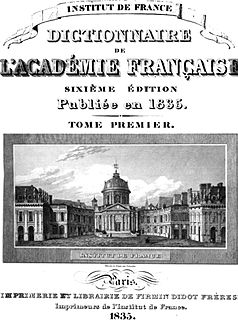 W
WThe Dictionnaire de l'Académie française is the official dictionary of the French language.
 W
WCatholicon is a 15th-century Breton-French-Latin dictionary. It is the first Breton dictionary and also the first French dictionary. It contains six thousand entries and was compiled in 1464 by the Breton priest Jehan Lagadeuc. It was printed in 1499 in Tréguier. A manuscript of the dictionary is preserved in the national library in Paris identified as Latin 7656.
 W
WThe Collins-Robert French Dictionary is a bilingual dictionary of English and French derived from the Collins Word Web, an analytical linguistics database. As well as its primary function as a bilingual dictionary, it also contains usage guides for English and French, English and French verb tables, and maps of English and French speaking areas.
 W
WThe Dictionnaire de la langue française by Émile Littré, commonly called simply the "Littré", is a four-volume dictionary of the French language published in Paris by Hachette.
 W
WThe Grand dictionnaire universel du XIXe siècle, often called the Grand Larousse du dix-neuvième, is a French encyclopedic dictionary. It was planned, directed, published, and to a substantial degree written by Pierre Larousse, though he also relied on anonymous fellow contributors and though he died in 1875, before its completion. The publication of the Grand dictionnaire universel in 15 volumes of 1500 pages extended from 1866 to 1876. Two supplements were published in 1877 and 1890.
 W
WThe Nouveau Larousse illustré was an illustrated French language encyclopedia published by Éditions Larousse between 1897 and 1904, in 7 volumes and a supplement. It was essentially a scaled-down version of the Grand dictionnaire universel du XIXe siècle of Pierre Larousse, but updated and written in a more neutral, scientific style under the editorship of Claude Augé (1854−1924).
 W
WLe Petit Larousse Illustré, commonly known simply as Le Petit Larousse, is a French-language encyclopedic dictionary published by Éditions Larousse. It first appeared in 1905 and was edited by Claude Augé, following Augé's Dictionnaire complet illustré (1889). The one-volume work has two main sections: a dictionary featuring common words and an encyclopedia of proper nouns. Le Petit Larousse 2007 includes 150,000 definitions and 5,000 illustrations. A Spanish-version El Pequeño Larousse Ilustrado and an Italian version Il Piccolo Rizzoli Larousse have also been published.
 W
WThe Dictionnaire de Trévoux, as the Dictionnaire universel françois et latin was unofficially and then officially nicknamed because of its original publication in the town of Trévoux, appeared in several editions from 1704 to 1771. Throughout the 18th century, it was widely assumed to be directed by the Jesuits, a supposition supported by at least some modern scholars.